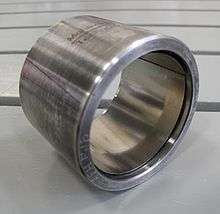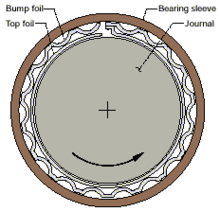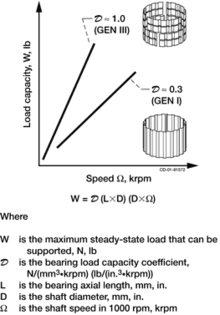Foil bearing

Foil bearings, also known as foil-air bearings, are a type of air bearing. A shaft is supported by a compliant, spring-loaded foil journal lining. Once the shaft is spinning fast enough, the working fluid (usually air) pushes the foil away from the shaft so that there is no contact. The shaft and foil are separated by the air's high pressure which is generated by the rotation which pulls gas into the bearing via viscosity effects. A high speed of the shaft with respect to the foil is required to initiate the air gap, and once this has been achieved, no wear occurs. Unlike aerostatic or hydrostatic bearings, foil bearings require no external pressurisation system for the working fluid, so the hydrodynamic bearing is self-starting.
Development


Foil bearings were first developed in the late 1950s by AiResearch Mfg. Co. of the Garrett Corporation using independent R&D funds to serve military and space applications.[1][2] They were first tested for commercial use in United Airlines Boeing 727 and Boeing 737 cooling turbines in the early- and mid-1960s.[3] Garrett AiResearch air cycle machine foil bearings were first installed as original equipment in 1969 in the DC-10's environmental control systems. Garrett AiResearch foil bearings were installed on all US military aircraft to replace existing oil-lubricated rolling-contact bearings. The ability to operate at cryogenic gas temperatures as well as at very high temperatures gave foil bearings many other potential applications.[4]
Current-generation foil bearings with advanced coatings have greatly exceeded the limitations of earlier designs. Anti-wear coatings exist that allow over 100,000 start/stop cycles for typical applications.[5]
Applications
Turbomachinery is the most common application because foil bearings operate at high speed.[6] The main advantage of foil bearings is the elimination of the oil systems required by traditional bearing designs. Other advantages are:
- Higher efficiency, due to a lower heat loss to friction; instead of fluid friction, the main source of heat is parasitic drag
- Increased reliability
- Higher speed capability
- Quieter operation
- Wider operating temperature range (40–2,500 K)
- High vibration and shock load capacity
- No scheduled maintenance
- No external support system
- Truly oil free where contamination is an issue
- Capable of operating above critical speed
Areas of current research are:
- Higher load capacity
- Improved damping
- Improved coatings
The main disadvantages are:
- Lower capacity than roller or oil bearings
- Wear during start-up and stopping
- High speed required for operation
See also
References
- ↑ Some early history is reported in Giri L. Agrawal (1997). "Foil Air/Gas Bearing Technology — An Overview" (PDF). Publication 97-GT-347. American Society of Mechanical Engineers.
- ↑ Giri L. Agrawal (July 1998). "Foil Bearings Cleared to Land". Mechanical Engineering. 1978-1980 (120).
- ↑ Scholer Bangs (February 1973). "Foil Bearings Help Air Passengers Keep their Cool". Power Transmission Design.
- ↑ M. A. Barnett and A. Silver (September 1970). "Application of Air Bearings to High-Speed Turbomachinery". Technical Paper No. 700720. Society of Automotive Engineers. 700720.
- ↑ Heshmat, Hooshang (September 2005). "Major Breakthrough in Load Capacity, Speed and Operating Temperature of Foil Thrust Bearings". Technical Paper No. WT2005-63712. American Society of Mechanical Engineers. WT2005-63712.
- ↑ R. M. "Fred" Klaass and Christopher DellaCorte (2006). "The Quest for Oil-Free Gas Turbine Engines". SAE Technical Papers. SAE. 2006-01-3055.
External links
- NASA Glenn Research Center "Creating a Turbomachinery Revolution"
- NASA Tribology & Mechanical Components Branch
- Turbomachinery and Energy System Laboratory at UTA
- Mohawk Innovative Technology, Inc.
- Tribology Group at Texas A&M
- Korean Institute for Science and Technology KIST
- Center for Rotating Machinery at LSU